英语论文参考文献格式要求
- 格式:doc
- 大小:89.00 KB
- 文档页数:11
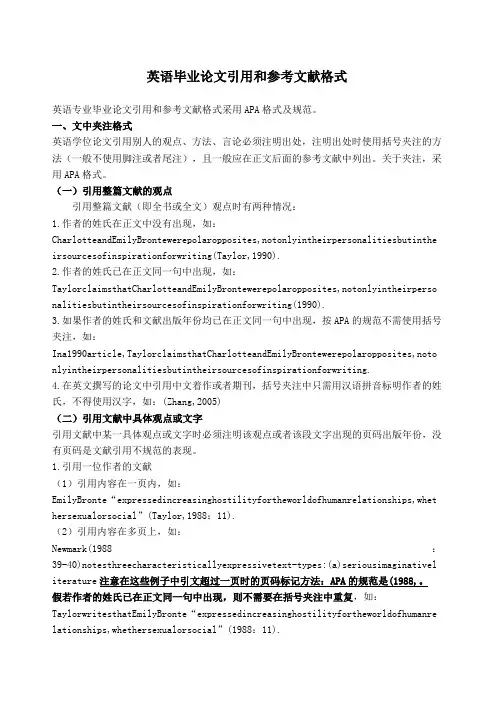
英语毕业论文引用和参考文献格式英语专业毕业论文引用和参考文献格式采用APA格式及规范。
一、文中夹注格式英语学位论文引用别人的观点、方法、言论必须注明出处,注明出处时使用括号夹注的方法(一般不使用脚注或者尾注),且一般应在正文后面的参考文献中列出。
关于夹注,采用APA格式。
(一)引用整篇文献的观点引用整篇文献(即全书或全文)观点时有两种情况:1.作者的姓氏在正文中没有出现,如:CharlotteandEmilyBrontewerepolaropposites,notonlyintheirpersonalitiesbutinthe irsourcesofinspirationforwriting(Taylor,1990).2.作者的姓氏已在正文同一句中出现,如:TaylorclaimsthatCharlotteandEmilyBrontewerepolaropposites,notonlyintheirperso nalitiesbutintheirsourcesofinspirationforwriting(1990).3.如果作者的姓氏和文献出版年份均已在正文同一句中出现,按APA的规范不需使用括号夹注,如:Ina1990article,TaylorclaimsthatCharlotteandEmilyBrontewerepolaropposites,noto nlyintheirpersonalitiesbutintheirsourcesofinspirationforwriting.4.在英文撰写的论文中引用中文着作或者期刊,括号夹注中只需用汉语拼音标明作者的姓氏,不得使用汉字,如:(Zhang,2005)(二)引用文献中具体观点或文字引用文献中某一具体观点或文字时必须注明该观点或者该段文字出现的页码出版年份,没有页码是文献引用不规范的表现。
1.引用一位作者的文献(1)引用内容在一页内,如:EmilyBronte“expressedincreasinghostilityfortheworldofhumanrelationships,whet hersexualorsocial”(Taylor,1988:11).(2)引用内容在多页上,如:Newmark(1988:39-40)notesthreecharacteristicallyexpressivetext-types:(a)seriousimaginativel iterature注意在这些例子中引文超过一页时的页码标记方法:APA的规范是(1988,。
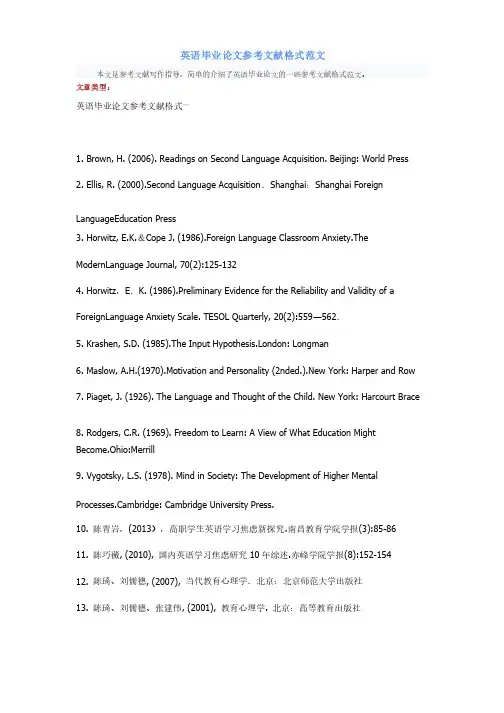
英语毕业论文参考文献格式范文本文是参考文献写作指导,简单的介绍了英语毕业论文的一些参考文献格式范文。
文章类型:英语毕业论文参考文献格式一英语毕业论文参考文献格式一1. Brown, H. (2006). Readings on Second Language Acquisition. Beijing: World Press2. Ellis, R. (2000).Second Language Acquisition .Shanghai :Shanghai Foreign LanguageEducation Press3. Horwitz, E.K.&Cope J. (1986).Foreign Language Classroom Anxiety.TheModernLanguage Journal, 70(2):125-1324. Horwitz ,E .K. (1986).Preliminary Evidence for the Reliability and Validity of a ForeignLanguage Anxiety Scale. TESOL Quarterly, 20(2):559ForeignLanguage Anxiety Scale. TESOL Quarterly, 20(2):559——562.5. Krashen, S.D. (1985).The Input Hypothesis.London: Longman6. Maslow, A.H.(1970).Motivation and Personality (2nded.).New York: Harper and Row7. Piaget, J. (1926). The Language and Thought of the Child. New York: Harcourt Brace8. Rodgers, C.R. (1969). Freedom to Learn: A View of What Education MightBecome.Ohio:Merrill9. Vygotsky, L.S. (1978). Mind in Society: The Development of Higher MentalProcesses.Cambridge: Cambridge University Press.10. 陈青岩,(2013),高职学生英语学习焦虑新探究.南昌教育学院学报(3):85-8611. 陈巧薇, (2010), 国内英语学习焦虑研究10年综述.赤峰学院学报(8):152-15412. 陈琦、刘儒德, (2007), 当代教育心理学.北京:北京师范大学出版社当代教育心理学.北京:北京师范大学出版社13. 陈琦、刘儒德、张建伟, (2001), 教育心理学. 北京:高等教育出版社北京:高等教育出版社14. 车文博, (2003), 人本主义心理学. 杭州:浙江教育出版社杭州:浙江教育出版社15. 郭永玉、王伟, (2007), 心理学导引.武汉:华中师范大学出版社心理学导引.武汉:华中师范大学出版社16. 贾冠杰, (2006), 二语习得论. 南京:东南大学出版社南京:东南大学出版社17. 贾冠杰,(2010),英语教学基础理论. 上海:上海外语教育出版上海:上海外语教育出版18. 刘文娟, (2010), 高职非英语专业学生英语学习焦虑的调查及其对策.济南职业学院学报(4):104-10619. 廖晓燕,桑龙扬, (2010), 高职院校学生英语学习焦虑降低的对策.九江学院学报(1):113-11520. 闵芬, (2008), A Case Study of Correlation between English Learners’ Anxiety andTheir Oral Performance in the Language Classroom, 中国知网中国优秀硕士学位论文全文数据库. 东华大学硕士学位论文东华大学硕士学位论文21. 王寅,(2007), 认知语言学. 上海: 上海外语教学研究出版社上海外语教学研究出版社22. 西格蒙德·弗洛伊德,林尘译, (2011), 自我与本我。
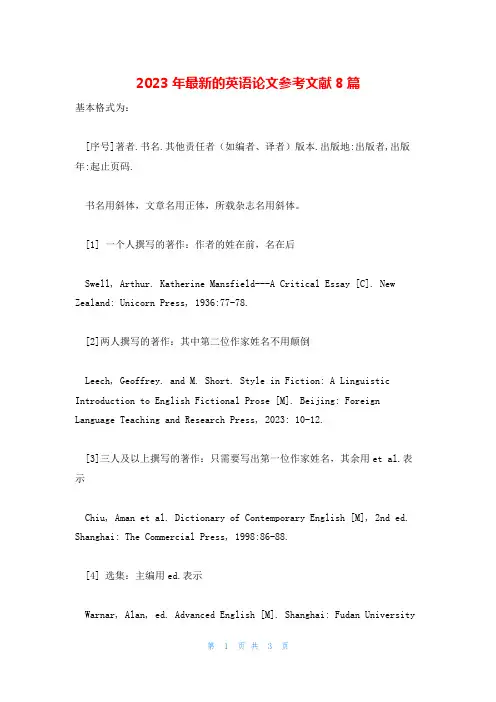
2023年最新的英语论文参考文献8篇基本格式为:[序号]著者.书名.其他责任者(如编者、译者)版本.出版地:出版者,出版年:起止页码.书名用斜体,文章名用正体,所载杂志名用斜体。
[1] 一个人撰写的著作:作者的姓在前,名在后Swell, Arthur. Katherine Mansfield---A Critical Essay [C]. New Zealand: Unicorn Press, 1936:77-78.[2]两人撰写的著作:其中第二位作家姓名不用颠倒Leech, Geoffrey. and M. Short. Style in Fiction: A Linguistic Introduction to English Fictional Prose [M]. Beijing: Foreign Language Teaching and Research Press, 2023: 10-12.[3]三人及以上撰写的著作:只需要写出第一位作家姓名,其余用et al.表示Chiu, Aman et al. Dictionary of Contemporary English [M], 2nd ed. Shanghai: The Commercial Press, 1998:86-88.[4] 选集:主编用ed.表示Warnar, Alan, ed. Advanced English [M]. Shanghai: Fudan UniversityPress, 2023: 102-103.[5] 译著:翻译用Trans.表示Flaubert, Gustave. Madae Bovary [M]. Trans. Gerard Hopkins. New York: Dell Publishing Company, Inc., 1959: 36-38.[6] 多人合著选集中的一篇文章Halliday, Michael. Linguistic Function and Literary Style: An Inquiry into the Language of William Golding’s The Inheritors [A], S. Chatman, ed. Literary Style: A Symposium [C]. Oxford: Oxford University Press, 1971: 45-47.[7] 作家论文集中的一篇文章[序号] 作者.题名.文集编者姓名.会议文集名.出版地:出版者,出版年:起止页码.Woolf, Virginia. A Terribly Sensitive Mind [A]. The Essays of Virginia Woolf [C], Vol. 4. London: The Hogarth Press, 1994:80-82.[8] 学术刊物中的论文[序号] 作者. 题名. 刊名, 出版年(期号): 起止页码.Miller, Hillis J. and Jin Huimin. The Permanent Rhetorical Reading [J]. Foreign Literature Review, 2023 (1): 141-143.[9] 网络或电子文献[序号] 主要负责者.题名.电子文献的出处或可获得地址,发表或更新日期/引用日期(任选).Gilles Fauconnier 所属学会;学历或授予的荣誉;所在单位;通讯地址和电子邮箱;电话和传真。
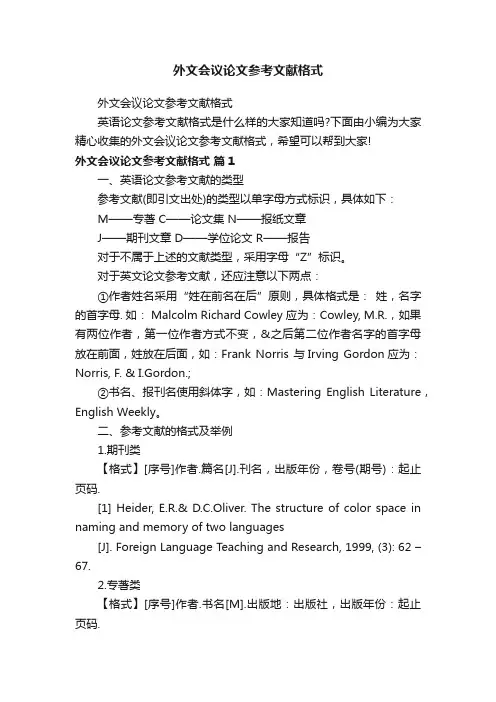
外文会议论文参考文献格式外文会议论文参考文献格式英语论文参考文献格式是什么样的大家知道吗?下面由小编为大家精心收集的外文会议论文参考文献格式,希望可以帮到大家!外文会议论文参考文献格式篇1一、英语论文参考文献的类型参考文献(即引文出处)的类型以单字母方式标识,具体如下:M——专著 C——论文集 N——报纸文章J——期刊文章 D——学位论文 R——报告对于不属于上述的文献类型,采用字母“Z”标识。
对于英文论文参考文献,还应注意以下两点:①作者姓名采用“姓在前名在后”原则,具体格式是:姓,名字的首字母. 如: Malcolm Richard Cowley 应为:Cowley, M.R.,如果有两位作者,第一位作者方式不变,&之后第二位作者名字的首字母放在前面,姓放在后面,如:Frank Norris 与Irving Gordon应为:Norris, F. & I.Gordon.;②书名、报刊名使用斜体字,如:Mastering English Literature,English Weekly。
二、参考文献的格式及举例1.期刊类【格式】[序号]作者.篇名[J].刊名,出版年份,卷号(期号):起止页码.[1] Heider, E.R.& D.C.Oliver. The structure of color space in naming and memory of two languages[J]. Foreign Language Teaching and Research, 1999, (3): 62 –67.2.专著类【格式】[序号]作者.书名[M].出版地:出版社,出版年份:起止页码.[1] Gill, R. Mastering English Literature [M]. London: Macmillan, 1985: 42-45.3.报纸类【格式】[序号]作者.篇名[N].报纸名,出版日期(版次).4.论文集【格式】[序号]作者.篇名[C].出版地:出版者,出版年份:起始页码.[1] Spivak,G. “Can the Subaltern Speak?”[A]. In C.Nelson & L. Grossberg(eds.). Victory in Limbo: Imigism [C]. Urbana: University of Illinois Press, 1988, pp.271-313.[2] Almarza, G.G. Student foreign language teacher’s knowledge growth [A]. In D.Freeman and J.C.Richards (eds.). Teacher Learning in Language T eaching [C]. New York: Cambridge University Press. 1996. pp.50-78.5.学位论文【格式】[序号]作者.篇名[D].出版地:保存者,出版年份:起始页码.6.研究报告【格式】[序号]作者.篇名[R].出版地:出版者,出版年份:起始页码.7.条例【格式】[序号]颁布单位.条例名称.发布日期8.译著【格式】[序号]原著作者. 书名[M].译者,译.出版地:出版社,出版年份:起止页码.三、注释注释是对论文正文中某一特定内容的.进一步解释或补充说明。
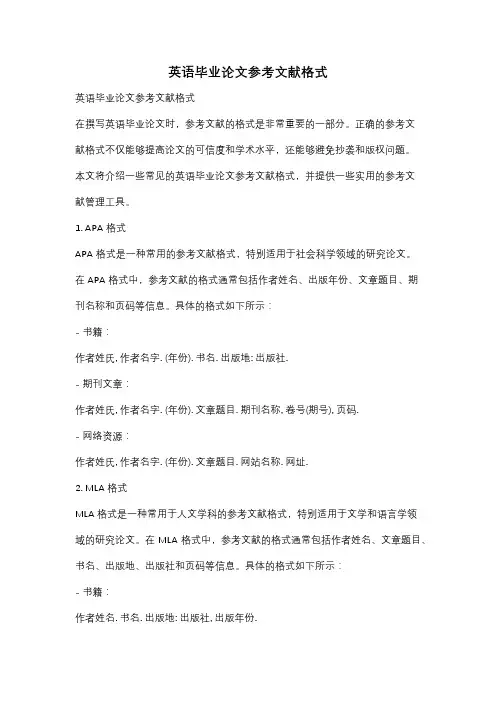
英语毕业论文参考文献格式英语毕业论文参考文献格式在撰写英语毕业论文时,参考文献的格式是非常重要的一部分。
正确的参考文献格式不仅能够提高论文的可信度和学术水平,还能够避免抄袭和版权问题。
本文将介绍一些常见的英语毕业论文参考文献格式,并提供一些实用的参考文献管理工具。
1. APA格式APA格式是一种常用的参考文献格式,特别适用于社会科学领域的研究论文。
在APA格式中,参考文献的格式通常包括作者姓名、出版年份、文章题目、期刊名称和页码等信息。
具体的格式如下所示:- 书籍:作者姓氏, 作者名字. (年份). 书名. 出版地: 出版社.- 期刊文章:作者姓氏, 作者名字. (年份). 文章题目. 期刊名称, 卷号(期号), 页码.- 网络资源:作者姓氏, 作者名字. (年份). 文章题目. 网站名称. 网址.2. MLA格式MLA格式是一种常用于人文学科的参考文献格式,特别适用于文学和语言学领域的研究论文。
在MLA格式中,参考文献的格式通常包括作者姓名、文章题目、书名、出版地、出版社和页码等信息。
具体的格式如下所示:- 书籍:作者姓名. 书名. 出版地: 出版社, 出版年份.- 期刊文章:作者姓名. "文章题目." 期刊名称, 卷号.期号 (年份): 页码.- 网络资源:作者姓名. "文章题目." 网站名称. 发布日期. 网址.3. Chicago格式Chicago格式是一种常用于历史和社会科学领域的参考文献格式,特别适用于长篇论文和学术著作。
在Chicago格式中,参考文献的格式通常包括作者姓名、文章题目、书名、出版地、出版社和页码等信息。
具体的格式如下所示:- 书籍:作者姓名. 书名. 出版地: 出版社, 出版年份.- 期刊文章:作者姓名. "文章题目." 期刊名称卷号, 期号 (年份): 页码.- 网络资源:作者姓名. "文章题目." 网站名称. 发布日期. 网址.除了以上提到的几种常见的参考文献格式外,不同学科领域还有一些特定的参考文献格式,如IEEE格式、Harvard格式等。

论文文献参考文献格式要求在撰写论文时,参考文献是不可或缺的一部分。
正确的参考文献格式不仅能够提高文献质量,还能为读者提供方便快捷的查阅方式。
本文将介绍常见的三种参考文献格式要求:APA、MLA和Chicago。
APA格式要求APA(American Psychological Association)格式是科学和社会科学领域写作的标准,适用于心理学、教育学、管理学等领域的论文写作。
其参考文献格式要求如下:•姓名首字母大写,全名缩写为三个字符,例如:Jones, L. C.•出版年份放在作者姓名之后,用括号括起来,例如:(2016)。
•文章标题首字母大写,剩余字母小写,用斜体表示,例如:An analysis of student motivation.•期刊名称只有首字母大写,不用斜体,例如:Journal of Educational Psychology, Annual Review of Psychology等。
•卷数和期数用斜体表示,例如:24(3)。
•页码或文献号码,例如:102-125或doi:10.1037/a0038497。
样例:Jones, L. C. (2016). An analysis of student motivation. Journal of Educational Psychology, 24(3), 102-125. doi:10.1037/a0038497MLA格式要求MLA(Modern Language Association)格式是人文学科领域写作的标准,适用于语言、文学、哲学等领域的论文写作。
其参考文献格式要求如下:•姓名全称,例如:Jones, Lisa C.•文章标题全部是小写,用双引号表示,例如:“An analys is of student motivation”。
•期刊名称用斜体表示,例如:Journal of Educational Psychology, Annual Review of Psychology等。
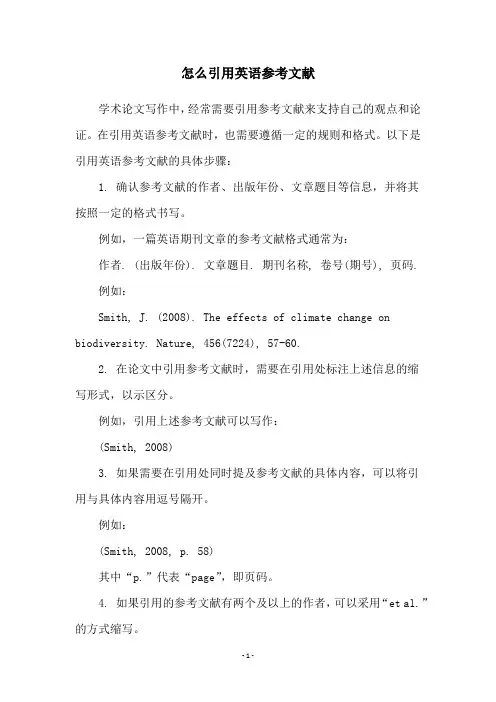
怎么引用英语参考文献
学术论文写作中,经常需要引用参考文献来支持自己的观点和论证。
在引用英语参考文献时,也需要遵循一定的规则和格式。
以下是引用英语参考文献的具体步骤:
1. 确认参考文献的作者、出版年份、文章题目等信息,并将其
按照一定的格式书写。
例如,一篇英语期刊文章的参考文献格式通常为:
作者. (出版年份). 文章题目. 期刊名称, 卷号(期号), 页码.
例如:
Smith, J. (2008). The effects of climate change on biodiversity. Nature, 456(7224), 57-60.
2. 在论文中引用参考文献时,需要在引用处标注上述信息的缩
写形式,以示区分。
例如,引用上述参考文献可以写作:
(Smith, 2008)
3. 如果需要在引用处同时提及参考文献的具体内容,可以将引
用与具体内容用逗号隔开。
例如:
(Smith, 2008, p. 58)
其中“p.”代表“page”,即页码。
4. 如果引用的参考文献有两个及以上的作者,可以采用“et al.”的方式缩写。
例如:
(Smith et al., 2008)
其中“et al.”代表“and others”,即“等人”。
总之,在引用英语参考文献时,需要注意书写格式和标注方式,以确保准确、清晰地表达自己的论点和观点。
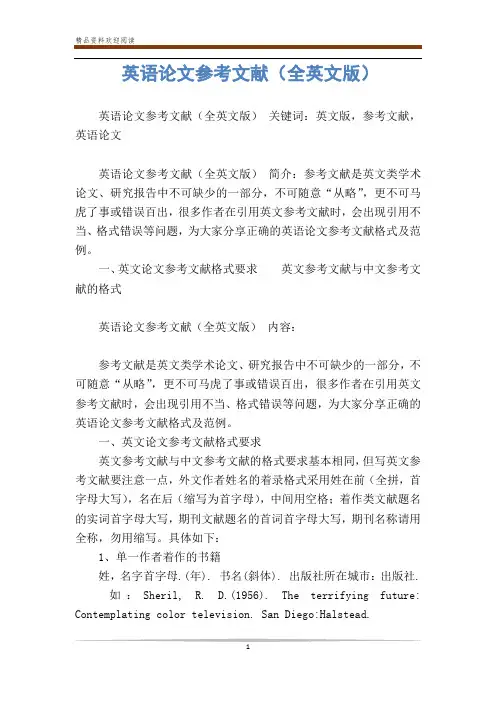
英语论文参考文献(全英文版)英语论文参考文献(全英文版)关键词:英文版,参考文献,英语论文英语论文参考文献(全英文版)简介:参考文献是英文类学术论文、研究报告中不可缺少的一部分,不可随意“从略”,更不可马虎了事或错误百出,很多作者在引用英文参考文献时,会出现引用不当、格式错误等问题,为大家分享正确的英语论文参考文献格式及范例。
一、英文论文参考文献格式要求英文参考文献与中文参考文献的格式英语论文参考文献(全英文版)内容:参考文献是英文类学术论文、研究报告中不可缺少的一部分,不可随意“从略”,更不可马虎了事或错误百出,很多作者在引用英文参考文献时,会出现引用不当、格式错误等问题,为大家分享正确的英语论文参考文献格式及范例。
一、英文论文参考文献格式要求英文参考文献与中文参考文献的格式要求基本相同,但写英文参考文献要注意一点,外文作者姓名的着录格式采用姓在前(全拼,首字母大写),名在后(缩写为首字母),中间用空格;着作类文献题名的实词首字母大写,期刊文献题名的首词首字母大写,期刊名称请用全称,勿用缩写。
具体如下:1、单一作者着作的书籍姓,名字首字母.(年). 书名(斜体). 出版社所在城市:出版社.如:Sheril, R. D.(1956). The terrifying future: Contemplating color television. San Diego:Halstead.2、两位作者以上合着的书籍姓,名字首字母., 姓,名字首字母.(年). 书名(斜体). 出版社所在城市:出版社.如:Smith, J., Peter, Q. (1992).Hairball: An intensive peek behind the surface of an enigma. Hamilton, ON:McMaster University Press.3、文集中的如:Mcdonalds, A.(1993). Practical methods for the apprehension and sustained containment ofsupernatural entities. In G. L. Yeager (Ed.), Paranormal and occult studies:Case studies in application (pp. 42–64). London: OtherWorld Books.4、期刊中的(非连续页码)如:Crackton, P.(1987). The Loonie: God's long-awaited gift to colourful pocket change?Canadian Change, 64(7), 34–37.5、期刊中的(连续页码):姓,名字首字母.(年). 题目. 期刊名(斜体). 第几期,页码.如:Rottweiler, F. T., Beauchemin, J. L. (1987). Detroit and Narnia: Two foes on the brink ofdestruction. Canadian/American Studies Journal, 54, 66–146.6、月刊杂志中的如:Henry, W. A., III.(1990, April 9). Making the grade in today's schools. Time, 135, 28-31.二、英文论文参考文献范例。
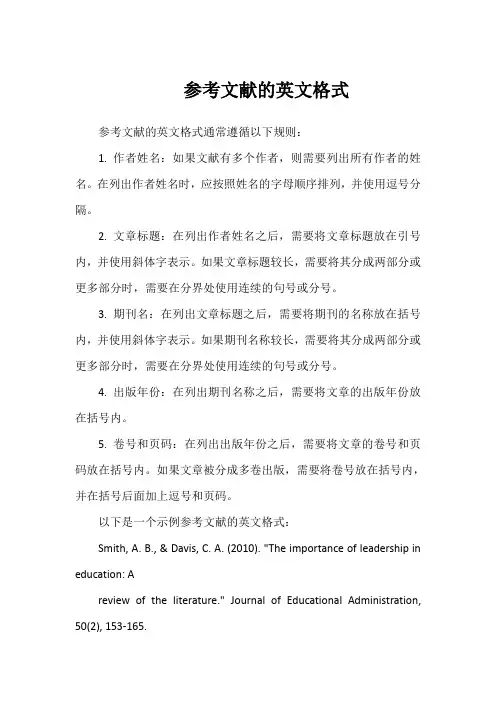
参考文献的英文格式
参考文献的英文格式通常遵循以下规则:
1. 作者姓名:如果文献有多个作者,则需要列出所有作者的姓名。
在列出作者姓名时,应按照姓名的字母顺序排列,并使用逗号分隔。
2. 文章标题:在列出作者姓名之后,需要将文章标题放在引号内,并使用斜体字表示。
如果文章标题较长,需要将其分成两部分或更多部分时,需要在分界处使用连续的句号或分号。
3. 期刊名:在列出文章标题之后,需要将期刊的名称放在括号内,并使用斜体字表示。
如果期刊名称较长,需要将其分成两部分或更多部分时,需要在分界处使用连续的句号或分号。
4. 出版年份:在列出期刊名称之后,需要将文章的出版年份放在括号内。
5. 卷号和页码:在列出出版年份之后,需要将文章的卷号和页码放在括号内。
如果文章被分成多卷出版,需要将卷号放在括号内,并在括号后面加上逗号和页码。
以下是一个示例参考文献的英文格式:
Smith, A. B., & Davis, C. A. (2010). "The importance of leadership in education: A
review of the literature." Journal of Educational Administration, 50(2), 153-165.。
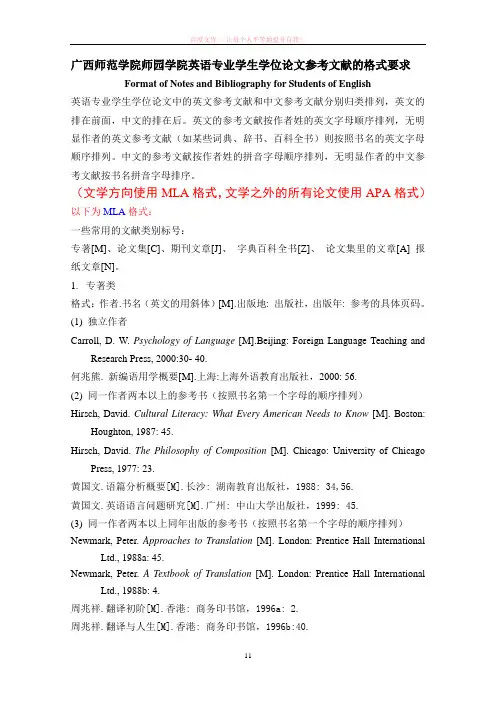
广西师范学院师园学院英语专业学生学位论文参考文献的格式要求Format of Notes and Bibliography for Students of English英语专业学生学位论文中的英文参考文献和中文参考文献分别归类排列,英文的排在前面,中文的排在后。
英文的参考文献按作者姓的英文字母顺序排列,无明显作者的英文参考文献(如某些词典、辞书、百科全书)则按照书名的英文字母顺序排列。
中文的参考文献按作者姓的拼音字母顺序排列,无明显作者的中文参考文献按书名拼音字母排序。
(文学方向使用MLA格式,文学之外的所有论文使用APA格式)以下为MLA格式:一些常用的文献类别标号:专著[M]、论文集[C]、期刊文章[J]、字典百科全书[Z]、论文集里的文章[A] 报纸文章[N]。
1.专著类格式:作者.书名(英文的用斜体)[M].出版地: 出版社,出版年: 参考的具体页码。
(1) 独立作者Carroll, D. W. Psychology of Language [M].Beijing: Foreign Language Teaching and Research Press, 2000:30- 40.何兆熊. 新编语用学概要[M].上海:上海外语教育出版社,2000: 56.(2) 同一作者两本以上的参考书(按照书名第一个字母的顺序排列)Hirsch, David. Cultural Literacy: What Every American Needs to Know [M]. Boston: Houghton, 1987: 45.Hirsch, David. The Philosophy of Composition[M]. Chicago: University of Chicago Press, 1977: 23.黄国文.语篇分析概要[M].长沙: 湖南教育出版社,1988: 34,56.黄国文.英语语言问题研究[M].广州: 中山大学出版社,1999: 45.(3) 同一作者两本以上同年出版的参考书(按照书名第一个字母的顺序排列)Newmark, Peter. Approaches to Translation[M]. London: Prentice Hall International Ltd., 1988a: 45.Newmark, Peter. A Textbook of Translation[M]. London: Prentice Hall International Ltd., 1988b: 4.周兆祥.翻译初阶[M].香港: 商务印书馆,1996a: 2.周兆祥.翻译与人生[M].香港: 商务印书馆,1996b:40.(4) 一本书有两、三位作者Halliday, M. A. K. & R. Hasan. Language, Context, and Text: Aspects of Language in a Social-semiotic Perspective [M]. Oxford: Oxford University Press, 1989: 6. (第一个作者姓+名,后面的作者名+姓)Berry, J., J. Foose & T. Jones. Up From the Cradle of Jazz: New Orleans Music Since World WarⅡ[M]. Athens: University of Georgia Press, 1986: 5.金圣华、黄国彬.因难见巧——名家翻译经验谈[M].香港: 三联书店有限公司,1996: 34.(5) 同一本书由有四位或更多的作者Edens, Walter. et al. Teaching Shakespeare [M]. Princeton: Princeton University Press, 1977: 45, 78.张三、李四等.语言杂谈[M].香港:三联书店有限公司,2002: 33.(6) 无作者署名的书Encyclopedia of Photography [Z]. New York: Crown, 1984: 90.现代汉语词典[Z]. 北京: 商务印书馆,1992: 2345.2.文章类格式:著者.题名[J].期刊名称.出版年,卷号(期号).文章的起止页码(1)期刊文章Goodman, K.S. Reading: a psycholinguistic guessing gam e [J]. Journal of the Reading Specialists,1967(6):126—135.华惠芳.阅读理解中的知识提取和信息加工[J].外语与外语教学, 2000(1):45-47.(2)论文集的文章Peter V oller. Does the teacher have a role in autonomous language learning? [A]. In Phil Benson & K. Johnson (eds.). Autonomy and Independence in Language Learning[C]. London: Longman, 1997: 101-203.张美芳.关系繁多的综合性学科 [A].梅德明、黄国文主编.语文研究群言集[C].广州: 中山大学出版社, 1997: 32.3.互联网资料格式:作者,文章题目,网上上传时间,网址(加下划线)。
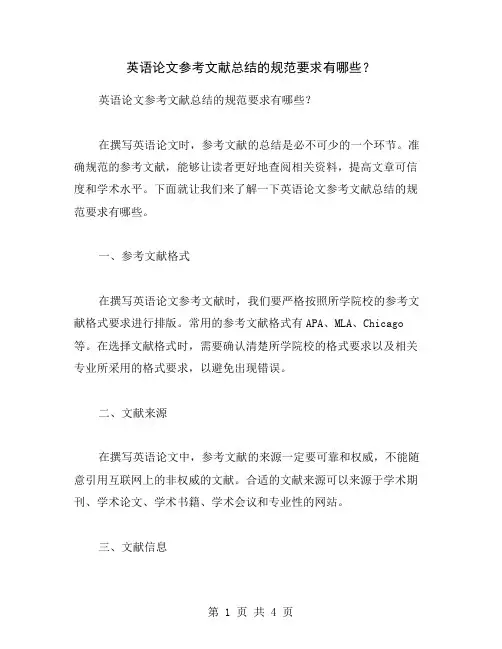
英语论文参考文献总结的规范要求有哪些?英语论文参考文献总结的规范要求有哪些?在撰写英语论文时,参考文献的总结是必不可少的一个环节。
准确规范的参考文献,能够让读者更好地查阅相关资料,提高文章可信度和学术水平。
下面就让我们来了解一下英语论文参考文献总结的规范要求有哪些。
一、参考文献格式在撰写英语论文参考文献时,我们要严格按照所学院校的参考文献格式要求进行排版。
常用的参考文献格式有APA、MLA、Chicago 等。
在选择文献格式时,需要确认清楚所学院校的格式要求以及相关专业所采用的格式要求,以避免出现错误。
二、文献来源在撰写英语论文中,参考文献的来源一定要可靠和权威,不能随意引用互联网上的非权威的文献。
合适的文献来源可以来源于学术期刊、学术论文、学术书籍、学术会议和专业性的网站。
三、文献信息在列写参考文献时,需要按照详实的要求信息完整的排版,一般需要包含以下信息:1. 作者(作者姓氏,名字首字母缩写)2. 出版年份(杂志、期刊或书籍的出版年限)3. 文章标题4. 杂志、期刊或书的标题5. 页码6. 出版地点和出版社四、文献数量在撰写英语论文参考文献时,不能任意添加一些没有真正引用到的文献。
参考文献的数量应当与文章相关内容相符,且不能低于规定数量。
五、文献顺序文献顺序是指列出的文献的排列次序。
一般情况下,按照字母顺序排列。
然而,在一些情况下,文献的排列次序会采取其他方式,例如文献按照出版年限排列和以文献作者的重要度作为排列的主要依据。
在这里我将举几个例子,帮助读者更好地理解参考文献的格式和规范要求。
Journal Article参考文献依次包括作者,出版年份,文章标题,杂志名称(字母大写和斜体),文献卷和期号,页码以及DOI(可选)。
样例:A. Smith. (2008). The critical role of reentry experiences in the lives of prisoners. Journal of Offender Rehabilitation, 46(3-4), 179-201. DOI:10.1080/10509670802141753.Book参考文献包括作者(姓氏,名字首字母缩写),出版年份,书名(字母大写)和出版商。
英语专业本科毕业论文参考文献格式要求I.文内引用(一)直接引用1.引用中的省略原始资料的引用:在正文中直接引用时,应给出作者、年份,并用带括号的数字标出页码。
若有任何资料省略,使用英文时,应用3个省略号在句中标出(…),中文用6个(……);若两句间的资料省略,英文应用4个省略号标出(‥‥),中文用6个(……)。
若要在直接引用插入自己的解释,应使用方括号[ ]。
若在资料中有什么错误拼写、错误语法或标点错误会使读者糊涂,应在引用后立即插入[sic],中文用[原文如此]。
下面是一些示例:例一:The DSM IV defines the disorder [dysthymic] as being in a chronically depressed mood that occurs for "most of the day more days than not for at least two years (Criterion A) .... In children, the mood may be irritable rather than depressed, and the required minimum duration is only one year" (APA, 1994, p. 345).例二:Issac (1995) states that bipolar disorder "is not only uncommon but may be the most diagnostic entity in children and adolescents in similar settings .... and may be the most common diagnosis in adolescents who are court-remanded to such settings" (p.275).2.大段落引用当中文引用超过160字时,不使用引号,而使用“块”的形式(引用起于新的一行,首行缩进4个空格,两端对齐,之后每行都缩进)。
英语毕业论文引用和参考文献格式英语专业毕业论文引用和参考文献格式采用APA 格式及规范。
一、文中夹注格式英语学位论文引用别人的观点、方法、言论必须注明出处,注明出处时使用括号夹注的方法(一般不使用脚注或者尾注),且一般应在正文后面的参考文献中列出。
关于夹注,采用 APA 格式。
(一)引用整篇文献的观点引用整篇文献(即全书或全文)观点时有两种情况:1.作者的姓氏在正文中没有出现,如:Charlotte and Emily Bronte were polar opposites, not only in their personalities butin their sources of inspiration for writing (Taylor, 1990).2.作者的姓氏已在正文同一句中出现,如:Taylor claims that Charlotte and Emily Bronte were polar opposites, not only intheir personalities but in their sources of inspiration for writing (1990).3. 如果作者的姓氏和文献出版年份均已在正文同一句中出现,按APA 的规范不需使用括号夹注,如:In a 1990 article, Taylor claims that Charlotte and Emily Bronte were polar opposites,not only in their personalities but in their sources of inspiration for writing.4.在英文撰写的论文中引用中文著作或者期刊,括号夹注中只需用汉语拼音标明作者的姓氏,不得使用汉字,如: (Zhang, 2005)(二)引用文献中具体观点或文字引用文献中某一具体观点或文字时必须注明该观点或者该段文字出现的页码出版年份,没有页码是文献引用不规范的表现。
英文论文的参考文献格式英文论文的参考文献格式很多刊物对参考文献和注释作出区分,将注释规定为“对正文中某一内容作进一步解释或补充说明的文字”,列于文末并与参考文献分列或置于当页脚地。
下面,小编为大家分享英文的.参考文献格式,希望对大家有所帮助!英文论文的参考文献格式一:[1] T. Paulay and J. R. Binney. Diagonally Reinforced coupling beams of shear Walls[S].ACI Special Publication 42, Detroit, 1974, 2: 579-598[2] Lam WY, Su R K L, Pam H J. Experimental study of plate-reinforced composite deep coupling beams[J]. Structural Design Tall Special Building, 2009(18): 235-257[3] ACI 318-02: Building Code Requirements for Structural Concrete, ACI318R-02:Commentary, An ACI Standard, reported by ACI Com-mittee318, American Concete Institute, 2002[4] Siu W H, Su R K L. Effects of plastic hinges on partial interaction behaviour of bolted side-plated beams[J]. Journal of Construction Steel Research, 2010, 66(5):622-633[5] Xie Q. State of the art of buckling-restrained braces inAsia[J]. Journal of Construction Steel Research, 2005, 61(6):727-748[6] Kim J,Chou H. Behavior and design of structures with buckling-restrained braces[J].Structural Engineering, 2004,26(6):693-706[7] Tsai K C, Lai J W. A study of buckling restrained seismic braced frame[J].Structural Engineering, Chinese Society of Structural Engineering, 2002, 17(2):3-32[8] Patrick J. Fortney, Bahrem M. Shahrooz, Gian A. Rassati.Large-Scale Testing of a Replaceable “Fuse” Steel Coupling Beam[J]. Journal of Structural Engineering.DECEMBER 2007:1801-1807[9] Qihong Zhao. Cyclic Behavior of traditional and Innovative Composite Shear Walls[J]. Journal of Structural Engineering, Feb. 2004:271-284英文论文的参考文献格式二:[1] Zhixin W, Chuanwen J, Qian A, et al. The key technology of offshore wind farm and its new development in China[J]. Renewable and Sustainable Energy Reviews, 2009, 13(1):216-222.[2] Shahir H, Pak A. Estimating liquefaction-induced settlement of shallow foundations by numerical approach[J]. Computers and Geotechnics, 2010, 37(3): 267-279.[3] Hausler EA. Influence of ground improvement on settlement and liquefaction:a study based on field case history evidence and dynamic geotechnicalcentrifuge tests. PhD dissertation, University of California, Berkeley; 2002.[4] Kemal Hac efendio lu. Stochastic seismic response analysis of offshore wind turbine including fluid‐structure‐soil interaction[J]. Struct. Design Tall Spec. Build.,2010,[5] Arablouei A, Gharabaghi A R M, Ghalandarzadeh A, et al. Effects of seawater–structure–soil interaction on seismic performance of caisson-type quay wall[J]. Computers &Structures, 2011, 89(23): 2439-2459.[6] Zafeirakos A, Gerolymos N. On the seismic response of under-designed caisson foundations[J]. Bulletin of Earthquake Engineering, 2013: 1-36.[7] Snyder B, Kaiser M J. Ecological and economic cost-benefit analysis of offshore wind energy[J]. Renewable Energy,2009, 34(6): 1567-1578.[8] Ding H, Qi L, Du X. Estimating soil liquefaction in ice-induced vibration of bucket foundation[J]. Journal of cold regions engineering, 2003, 17(2): 60-67.[9] Shooshpasha I, Bagheri M. The effects of surcharge on liquefaction resistance of silty sand[J]. Arabian Journal of Geosciences, 2012: 1-7.[10] Bhattacharya S, Adhikari S. Experimental validation of soil–structure interaction of offshore wind turbines[J]. Soil dynamics and earthquake engineering, 2011, 31(5): 805-816.[11] H. Bolton Seed, Izzat M. Idriss. Simplified procedure for evaluating soilliquafaction potential. Journal of the Soil Mechanics and Foundations Division. 1971,97(9): 1249-1273[12] W. D. Liam Finn, Geoffrey R.Martin, Kwok W.Lee. An effective stress model for liquefaction. Journal of the Geotechnical Engineering Division, 1977, 103(6):517-533[13] Seed.H.B.Soil liquefaction and Cyclic Mobility Evolution for Level Ground During Earthquakes, J of the Geotechnical Engineering Division ASCE , 1979,[14] Casagrande.A,Liquefaction and Cyclic Deformation of Sands-A Critical Review,Proceedings of the Fifth Pan American Conference on Soil Mechanics and Foundation Engineering,Buenos Aires,Argentina,1975.。
英语毕业论文引用和参考文献格式一、文中夹注格式英语学位论文引用别人的观点、方法、言论必须注明出处,注明出处时应该使用括号夹注的方法,一般不使用脚注或者尾注。
关于夹注,采用APA格式。
〔一〕引用整篇文献的观点引用整篇文献〔即全书或全文〕观点时有两种情况。
1.作者的姓氏在正文中没有出现Charlotte and Emily Bronte were polar opposites, not only in their personalities but in their sources of inspiration for writing (Taylor, 1990).2. 作者的姓氏已在正文同一句中出现Taylor claims that Charlotte and Emily Bronte were polar opposites, not only in their personalities but in their sources of inspiration for writing (1990).3. 假如作者的姓氏和文献出版年份均已在正文同一句中出现,按APA的标准不需使用括号夹注In a 1990 article, Taylor claims that Charlotte and Emily Bronte were polar opposites, not only in their personalities but in their sources of inspiration for writing.4. 在英文撰写的论文中引用中文著作或者期刊,括号夹注中只需用汉语拼音标明作者的姓氏,不得使用汉字,如:(Zhang, 2005)〔二〕引用文献中详细观点或文字引用文献中某一详细观点或文字时必须注明该观点或者该段文字出现的页码出版年份,没有页码是文献引用不标准的表现。
1.引用一个作者文献〔1〕引用内容在一页内Emily Bronte “expressed increasing hostility for the world of human relationships, whether sexual or social〞(Taylor, 1988, p. 11).〔2〕引用内容在多页上Newmark (1988, pp. 39-40) notes three characteristically expressive text-types: (a) serious imaginative literature (e.g. lyrical poetry); (b) authoritative statements (political speeches and documents, statutes and legal documents, philosophical and academic works by acknowledged authorities); (c) autobiography, essays, personal correspondence (when these are personal effusions).注意在这些例子中引文超过一页时的页码标记方法:APA的标准是(1988, pp. 39-40)。
sci英语参考文献字号字体要求标准一、引言SCI(科学引文索引)是全球范围内最具影响力的学术论文检索工具之一,被广泛用于评价科学研究的水平与影响力。
在SCI论文中,正确、规范地引用参考文献是学术规范的基本要求之一。
本文将介绍SCI英语参考文献的字号字体要求标准,帮助作者更好地遵守学术规范。
二、字号要求1.正文中的引用号应以小五号字或五号字为宜,以避免与正文文字混淆。
2.英文文献引用号应以TimesNewRoman或Arial字体,字号以五号字或小五号字为宜。
3.图表、公式、图注、表注等引文内容,应采用与正文不同的字体或字号,以便区分。
三、行距与间距1.参考文献列表应以等行距、等间距排版,以便于读者阅读和查找。
2.同一文献内不同引文内容之间应保持适当的间距,以避免混淆。
四、格式要求1.参考文献列表应按照文献类型进行分类,如期刊文章、书籍、会议论文等,以便于读者查找和使用。
2.引用格式应按照所使用软件的要求进行设置,确保参考文献能够正确被检索和引用。
常见的引用格式包括APA、MLA、Chicago等。
3.作者姓名应使用汉语拼音,并在必要时加上缩写点。
如果引用的是团体作品,则无需添加作者姓名。
五、示例以下是一个SCI英语参考文献的示例:[1]Smith,J.(2019)."Thisisatest".JournalofScience,1(2),50-55.[2]Brown,P.,&Johnson,M.(2020)."Thisisacasestudyreference" .InG.Marx(Ed.),CaseStudiesinTechnology(pp.15-30).AcademicPress.六、总结SCI英语参考文献的字号字体要求标准对于学术规范至关重要。
本文介绍了字号、行距、间距以及格式等方面的要求,并给出了示例。
希望能够帮助广大作者更好地遵守学术规范,提高论文的质量和影响力。
英语专业本科毕业论文参考文献格式要求I.文内引用(一)直接引用1.引用中的省略原始资料的引用:在正文中直接引用时,应给出作者、年份,并用带括号的数字标出页码。
若有任何资料省略,使用英文时,应用3个省略号在句中标出(…),中文用6个(……);若两句间的资料省略,英文应用4个省略号标出(‥‥),中文用6个(……)。
若要在直接引用插入自己的解释,应使用方括号[ ]。
若在资料中有什么错误拼写、错误语法或标点错误会使读者糊涂,应在引用后立即插入[sic],中文用[原文如此]。
下面是一些示例:例一:The DSM IV defines the disorder [dysthymic] as being in a chronically depressed mood that occurs for "most of the day more days than not for at least two years (Criterion A) .... In children, the mood may be irritable rather than depressed, and the required minimum duration is only one year" (APA, 1994, p. 345).例二:Issac (1995) states that bipolar disorder "is not only uncommon but may be the most diagnostic entity in children and adolescents in similar settings .... and may be the most common diagnosis in adolescents who are court-remanded to such settings" (p.275).2.大段落引用当中文引用超过160字时,不使用引号,而使用“块”的形式(引用起于新的一行,首行缩进4个空格,两端对齐,之后每行都缩进)。
当英文引用超过40字时,不使用引号,而使用“块”的形式(引用起于新的一行,首行缩进5个空格,左对齐,之后每行都缩进)。
Elkind (1978) states:In general, our findings support Piaget's view that perceptionsas well as intelligence are neither entirely inborn nor entirelyinnate but are rather progressively constructed through thegradual development of perceptual regulations. The chapter hasalso attempted to demonstrate the applicability of Piaget'stheory to practical issues by summarizing some research growingout of an analysis of beginning reading. (p.183)(二)间接引用1.基本格式同作者在同一段中重复被引用时,第一次必须写出日期,第二次以后则日期可省略。
a.英文文献:In a recent study of reaction times, Walker (2000)described the method…Walker also found…。
b.中文文献:李福印(2004)提出概念隐喻的重要性,…;李福印同时建议…。
2. 单一作者a. 英文文献:姓氏(出版或发表年代)或(姓氏,出版或发表年代)。
例如:Porter (2001)…或…(Porter, 2001)。
b. 中文文献:姓名(出版或发表年代)或(姓名,出版或发表年代)。
例如:杨惠中(2011)…或…(杨惠中,2011)。
3.两个作者英文引用时,在圆括号内使用两名作者的姓氏,并使用“&”来连接,在正文中,使用“and”连接两名作者。
中文引用时,在圆括号内使用两名作者的姓名,并用顿号“、”来连接,在正文中,使用“和”、“与”、“及”等字连接两名作者。
例如:(Smith & Jones, 1994), or Smith and Jones (1994) found....In 1994 Smith and Jones researched.... Always cite both names in text.陈国华和田兵(2008)认为…或…(陈国华、田兵,2008)4.三至五个作者英文第一次引用参考资料时,列出所有的作者的姓氏,除最后一名作者之前在正文中使用逗号加“and”、在圆括号内使用逗号加“&”连接外,之前的其他作者之间使用逗号“,”;之后引用时,英文用第一个作者的姓随之以“et al.”。
中文第一次引用参考资料时,列出所有作者的姓名,除最后两名作者之间用“和”连接外,之前的其他作者之间使用顿号“、”;之后引用时,用第一名作者加“等”字。
例如:Strasburger, Jorgensen, and Randles (1996) found differences.... (第一次使用).Strasburger et al. (1996) also created tests.... (在段落中第二次使用).Starsburger et al. found discrepancies.... (在同一段落中再次使用,此时省略年份).卫乃兴、李文中与濮建忠(2005)指出…或…(卫乃兴、李文中、濮建忠,2005)。
(第一次使用)卫乃兴等(2005)指出…或…(卫乃兴等,2005)。
(第二次使用)5.六个作者及以上使用英文时,只用第一个人的姓氏加“et al.”;使用中文时,只列出第一名作者的姓名,再加上“等”。
例如:Pouliquen et al. (2003)……或……(Pouliquen et al., 2003)王洪俊等(2007)…或…(王洪俊等,2007)6.团体作者使用中文时,第一次用全称,比如,(首都师范大学教育科学学院[首师大教科院],2001);之后可以用简称,比如,首师大教科院(2001)的调查表明……。
使用英文时,第一次引用时,拼出团体,比如, (National Institute of Mental Health [NIMH], 1996);以后用团体缩写加年份表示,比如,The NIMH (1996) examined....。
7.没有作者的文献当一部作品没有作者时,在文中引用参考文献目录单中的前几个字(通常是标题)和年份。
比如,一项关于成年人抑郁症的调查(“Study Finds”, 1997)报告……。
当某作品的作者列为“Anonymous”、中文使用“匿名”或“无名氏”时,英文引用时用“Anonymous”加逗号及年份,即(Anonymous, 1997),中文用“匿名”加逗号及年份,即(匿名,1997)。
8.英文文献作者姓氏相同英文文献作者姓氏相同時,相同姓氏之作者于论文中引用时均引用全名,以避免混淆。
例如:R. D. Luce (1995) and G. E. Luce (1988)…。
9.多篇文献a. 多篇文献,同一作者若一作者有多篇你想引用的文献,只需用逗号“,”来区隔作品的发表年份(最早到最晚依序排列)。
若多篇文献在同一年内发表,请在年份后面加上a、b、c……等标注。
(按:abc的使用需与参考文献部分有所对应,而这些文献的编排以标题名称的字母来决定。
)例如:1)A recent study found a possible genetic cause of alcoholism (Pauling, 2004, 2005a, 2005b).2)Pauling (2004, 2005a, 2005b) conducted a study that discovered a possible genetic cause of alcoholismb.多篇文献,多位作者文献依姓氏字母(笔画)、出版年代等顺序排列,不同作者之间用分号“;”分开,相同作者不同年代之文献用逗号“,”分开。
例如:…(Pautler, 1992; Razik & Swanson, 1993a, 1993b)。
例如:…(董伟,2010;周音,2011a,2011b)。
II.参考文献所有的参考文献使用“悬挂缩进”格式。
参考文献按照作者姓的字母或拼音顺序排列于文后,参考文献的序号左顶格,并用数字加方括号表示,如[1]、[2]、…。
排列顺序为先列英文文献,后列中文文献(如有中文参考文献的话)。
英文文献使用英文标点符号,而中文文献则应使用中文标点符号。
1.著作类文献的基本格式(1)独立作者的文献的格式[序号]+空格+姓名(英文:作者姓+逗号+空格+作者名字的首字母)+点+空格+(出版年代)+点+专著名称(英文斜体)+[参考文献标识]+点+空格+出版地点+冒号+空格+出版公司+点。
英文书名的每个单词(冠词和介词除外,除非在句首)的首字母都要大写,标点一律用西文标点。
中文文献的格式为:[序号]+空格+作者姓名+空格+(出版年代)+句号+专著名称(须加书名号)+[参考文献标识]+句号+出版地点+冒号+空格+出版公司+句号。
[1] 陈福康(2000)。
《中国译学理论史稿》[M]。
上海: 上海外语教育出版社。
[2] Booth, C.(1983). The Rhetoric of Fiction [M]. England: Penguin Books.(2)同一作者同年出版的两种或两种以上的文献[3] 周兆祥 (1996a)。
《翻译人与人生》[M]。
香港: 商务印书馆。
[4] 周兆祥 (1996b)。
《翻译初阶》[M]。
香港: 商务印书馆。
[5] Newmark, P.(1988a). Approaches to Translation [M]. London: PrenticeHall International Ltd..[6] Newmark, P.(1988b). A Textbook of Translation [M]. London: PrenticeHall International Ltd..(3)两位、三位作者的文献两位、三位作者的文献,英文的后两位作者姓名之间用&连接;使用中文时,两名作者之间使用“和”连接。